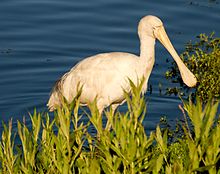Yellow beaked spoonbill
| Yellow beaked spoonbill | ||||||||||
|---|---|---|---|---|---|---|---|---|---|---|

Yellow-billed spoonbill ( Platalea flavipes ) |
||||||||||
| Systematics | ||||||||||
|
||||||||||
| Scientific name | ||||||||||
| Platalea flavipes | ||||||||||
| Gould , 1838 |
The yellow-billed spoonbill ( Platalea flavipes ) is a species of bird in the family of ibises and spoonbills (Threskiornithidae). Some authors place it in the monotypical genus Platibis .
The IUCN classifies the yellow-billed spoonbill as not endangered ( least concern ).
distribution and habitat
It occurs in Australia and lives there in brackish or fresh waters inland, rarely also in tide pools or other protected areas on the coast. Odd guests also occasionally reach New Zealand, Lord Howe Island and Norfolk Island .
The yellow spoonbill is more common than the king spoonbill in small wetlands, water reservoirs and ponds than the king spoonbill. Due to its beak shape, it is dependent on shallow water zones that are no deeper than 40 centimeters. The construction of water dams and canals has contributed to the fact that the distribution area of the yellow-billed spoonbill has expanded. In its original range, however, it has become rarer because some of these wetlands have been converted into agricultural areas.
In Victoria the yellow-billed spoonbill are resident birds, in the other areas they make seasonal migrations.
features
The yellow-beaked spoonbill reaches a body length of 76 to 92 centimeters. The body accounts for about half of this. The weight is between 1814 and 1928 grams. Males grow larger and have longer bills and legs. Brooding, adult birds have long decorative feathers above the chest. The bare part of the facial skin is brightly colored. Young birds have black wing tips.
There is a possibility of confusion with the king spoonbill , which is similar in body shape to the yellow-billed spoonbill. Yellow-billed spoonbills, however, are somewhat larger and have a longer beak and have no feathers during the breeding season. Unlike the yellow-billed spoonbill, the king spoonbill also has a black beak and black legs and feet.
As a rule, the yellow-billed spoonbill moves with slow and calm steps. Only occasionally is prey pursued at a faster rate. Foraging yellow-billed spoonbills have dipped their beak into the water and move it through the water with a sideways head movement. The beak is slightly open. They also often rest on tree branches that extend over the water. Outside of the breeding season, they are not very happy to call. During the breeding season, a gasping hiss can be heard from them near the breeding grounds. In flight it resembles the king spoonbill with its outstretched feet and neck. On longer flights, fast, even wing beats alternate with short gliding phases. By using thermals , they occasionally reach very great heights.
Food and subsistence
Yellow-billed spoonbills feed mainly on water-dwelling insects, especially back swimmers , as well as crayfish , shrimp, fish, molluscs and plant material. When looking for food, they swing their beak back and forth more slowly than the king spoonbill ( P. regia ) living in the same area and feed on smaller prey than this. When searching for food, the beak is about two to four centimeters wide open, the tip of the beak is guided in an arc of 120 degrees. If the beak is at the extreme end of such an arch, the foot is set forward on the opposite side. In doing so, it whirls up the soil substrate and thus also prey animals. Underwater plants are usually examined for possible prey with quick, lateral beak movements. Basically, prey is localized by the sense of touch and the beak is closed when the prey touches the inside of the beak. Accordingly, prey that swims freely in the water dominates the food spectrum of the yellow-billed spoonbill. In contrast, there is a lack of prey that live on aquatic plants or in the soil. The prey is swallowed by raising the beak 60 degrees above the horizontal.
Reproduction
Yellow-billed spoonbills enter into a monogamous couple relationship that presumably lasts longer than one reproductive period.
Yellow-billed spoonbills breed in southern Australia from September to April and in the north from March to May. The breeding season varies depending on local weather conditions. They nest alone or in loose colonies of a few pairs. Small colonies are typical, with two nests within 30 to 50 meters. The nest is a loose platform made of twigs and branches, in reed areas also made of reeds. Only the immediate nesting area is defended.
Two to four, usually three eggs are laid, which are incubated for 26 to 31 days. Both parent birds are involved in the breeding and rearing of the young birds. The chicks initially have white down plumage. The duration of the nestling period has not yet been adequately investigated; it probably extends to five weeks. In Kerang , breeding success was observed over two breeding seasons. A total of 75 nests were started there; juveniles fledged in only 54 nests. A total of 103 young birds flew out.
Web links
- Platalea flavipes in the endangered Red List species the IUCN 2009. Posted by: BirdLife International, 2009. Retrieved on January 29 of 2010.
- Videos, photos and sound recordings of Platalea flavipes in the Internet Bird Collection
literature
- PJ Higgins (Ed.): Handbook of Australian, New Zealand & Antarctic Birds. Volume 1: Ratites to Ducks. Oxford University Press, Oxford 1990, ISBN 0-19-553068-3 .
- Josep del Hoyo et al. a .: Handbook of the Birds of the World. Volume 1: Ostrich to Ducks. Lynx Edicions, 1992, ISBN 84-87334-10-5 .

